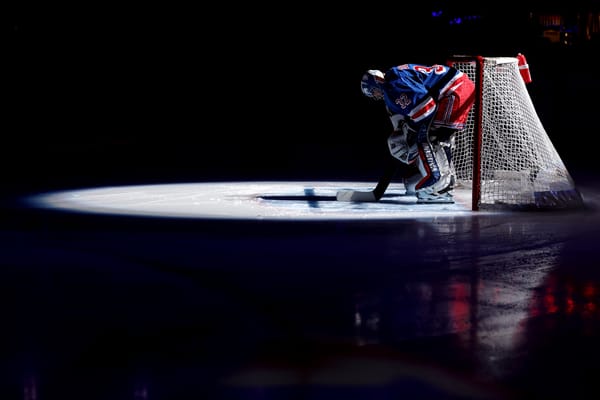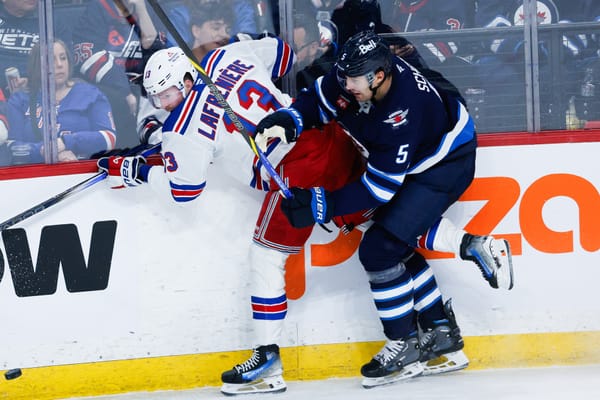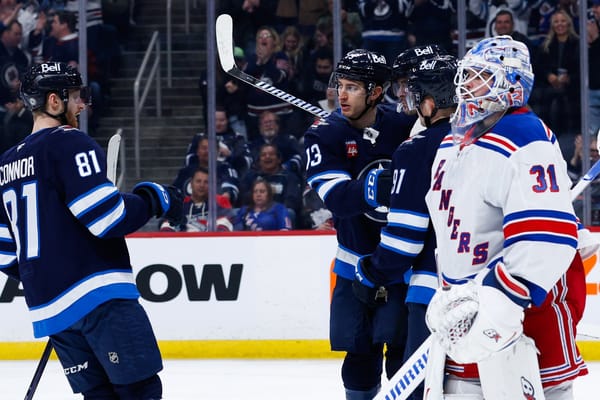Cat Silverman shares her thoughts on Rangers goaltending prospect Olof Lindbom
Cat Silverman offers her insight on Lindbom and the development of European goaltending prospects
When the New York Rangers selected Olof Lindbom with the 39th pick of the 2018 NHL Draft, it triggered a lot of discussion. At the time, NHL Central Scouting had him ranked at the #5 spot among European goaltenders, so it was surprising when he was the first goalie selected in the draft. Fourteen months and a few injuries later, that discussion continues.
Olof Lindbom to #NYR, and we have our first goalie off the board. I had him as my #6-ranked goalie, so a bit surprising to see him picked first. Very technical, very structured. Can he track when the game speeds up at the next level? That is the big question.
— Gregory Balloch (@GregBalloch) June 23, 2018
There have been a lot of theories as to why the Rangers scouting department fell in love with Lindbom, but few of them have gone into detail. So, Blueshirt Banter reached out to Cat Silverman of In Goal Magazine and The Athletic to gain some insight. Just as we expected, Cat brought the thunder.
A Reach?
The first question we had for Cat was what she thought the Rangers might have seen in the 6-foot-2 netminder. After all, many considered Lindbom to be a pretty big reach as the 39th overall selection of the 2018 Draft.
“Honestly, I was a little surprised by it — but I’ve heard that [Benoit] Allaire had a hand in the decision and the team clearly has a strong scouting presence overseas,” Silverman told Blueshirt Banter. “Lindbom looks like a pretty prototypical Swedish goaltending prospect, but it’s possible that the Rangers brass had watched his progression enough over the last few years to feel confident that his rate of development and his strong areas were high-end.
“The problem with scouting European prospects is that it can be tough to dig up film footage to compare their improvement from year to year; for the Rangers, Lindbom may have shown the right improvements over the right time frame to give the team confidence that he was the prospect with the highest ceiling,” Silverman added.
Silverman also noted that last year’s goaltending draft class was particularly weak. It’s no secret that the Rangers have been hungry to bolster their prospect depth over the last few years. With that in mind, it makes sense that the team took the goaltender that they felt the most confident in — especially if the team’s resident goalie whisperer liked what he saw.
With that being said, the Swedish prospect was one of just two goaltenders — the other being Olivier Rodrigue — selected in the second round of the 2018 Draft. There was a bit of a goalie blitz in the third round, but the Rangers did have two picks in that round (70th and 88th). So, it’s understandable why selecting Lindbom is still regarded as a reach by many fans and analysts. The fact that he wasn’t present at the draft itself only added fuel to that fire.
Since the Draft
The Rangers were probably itching to see Lindbom silence some of the naysayers with a big season in 2018-19, but that is not what happened. Lindbom’s season in the SuperElit with Djurgårdens IF J20 team was completely derailed by a concussion.
Including the SuperElit playoffs, Lindbom tended goal for a total of 543 minutes for Djurgårdens IF J20. He posted a .900 save percentage and earned wins in five of his eight appearances in the regular season before stopping 24 of the 26 shots he faced against Frölunda HC J20 in the third-place match of the playoffs. He also was called up to serve as the backup for Djurgårdens senior team for three games, but saw no action in the SHL last year.
Related
Blueshirt Banter 2019 New York Rangers Prospect Rankings: 20-16
In addition to throwing his season with Djurgården into upheaval, Lindbom’s concussion also prevented him from representing Sweden at the World Junior Championship. Considering how damaging Lindbom’s concussion was to his 2018-19 season, it’s understandable why so many feared the worst when Philadelphia Flyers prospect Bobby Brink made contact with his head and sent his helmet flying into the corner at the World Junior Summer Series.
Bobby Brink kicks off a small melee as he collides with Olof Lindbom attempting to corral a loose puck behind the net.
— Stars n’ Stripes Hockey (@StarsStripesHKY) July 31, 2019
Brink knocks Lindbom's helmet off in the process and the Swedes naturally take exception. Lindbom appeared to be ok and stayed in the game. #WJSS #Flyers #NYR pic.twitter.com/S4eVJ5huhf
Tomas Monten, Team Sweden’s head coach, decided to pull Lindbom from the game as a precaution after that scary collision. Fortunately, Adam Kimmelman and others reported that the Rangers prospect did not suffer a concussion. However, the soreness he experienced in his neck and back prevented him from appearing in Sweden’s remaining two games at the WJSS.
“He’s a lot better,” Monten told Kimmelman. “He feels good, hasn’t felt anything from the hit. He’s up and running but we’re just going to hold him off. He’s got soreness in the neck and the back but no concussion. (It) was good news.”
Before that collision, Lindbom stopped 20 of the 23 shots he faced, some of which were some pretty big saves.
John Beecher with another prime scoring chance off the Sweden turnover. Blake McLaughlin with the nifty pass springs Beecher, but Olof Lindbom is up to the task. #WJSS #NHLBruins #LetsGoDucks #NYR pic.twitter.com/9JHtYDG5XK
— Stars n’ Stripes Hockey (@StarsStripesHKY) July 31, 2019
Unfortunately, it’s not uncommon for goaltenders to have their careers jeopardized and some of their potential spoiled by injuries. So, just how concerned should the Rangers be that Lindbom suffered what appeared to be a serious concussion at the age of 18?
“With goaltenders, concussions are always a very real concern — not just because repeat concussions can be so severe, but because the position is so cerebral and there’s such a small margin of error,” Silverman explained. “The gap between NHL starters and replacement-level AHLers can be nothing more than a split-second difference in reaction speed and situational reads, which can be the difference between a fully healthy goaltender and one suffering from any post-concussion aftereffects.
“That being said, plenty of Swedish teams were interested in bringing Lindbom on this upcoming season, which wouldn’t have been the case if they were worried he’d still be suffering from concussion effects,” she continued. “I wouldn’t be too worried, at least for now.”
Setting Expectations
Lindbom will play for Mora IK in Sweden’s Allsvenskan next season. Last season, three goalies who were drafted by NHL teams played in Allsvenskan — Olle Eriksson Ek (Anaheim Ducks), Arvid Holm (Winnipeg Jets), and Samuel Ersson (Philadelphia Flyers). Impressively, Eriksson Ek, 20, is making the jump from the Allsvenskan to the AHL this season.
So, is there a target age for a goalie prospect to make the jump from Europe to the AHL or straight to the NHL? As it turns out, there really isn’t much of a playbook. As we all know, goalies are pretty much voodoo and their development is far from a precise science.
“I don’t think there is a ‘target age’ for the jump, to be honest,” Silverman told Blueshirt Banter. “Just like skaters, some goaltenders need longer than others and they all need different development focuses before they are ready for North America; some have technical issues, others need to work on their mental game, and others are still waiting on either physical or mental maturity. Some may need to improve conditioning, while others are physically ready before they can emotionally handle the grind; some are still very raw at 22 and others have been too over-coached and need to gain comfort at each level in order to branch out and become more creative.”
Nice sequence for Bobby Brink and Alex Turcotte, as Turcotte back checks to break up the Sweden chance.
— Stars n’ Stripes Hockey (@StarsStripesHKY) July 31, 2019
The puck then heads the other way and Turcotte is denied on a pretty glove save from Olof Lindbom. #WJSS #LaKings #Flyers pic.twitter.com/7o9OIVDlpJ
So, why is it that some goaltenders take longer than others to make that jump? As it turns out, the answer to that question is relatively straightforward; each goalie is different and there are only so many starts to go around.
“The biggest reason we see goaltenders take longer is because of roster spots, simple as that,” Silverman explained. “Just like forwards and defensive prospects, goaltenders have to play in order to develop and improve — but unlike their other positional teammates, they can’t be eased into a role with sheltered deployment and limited minutes.
“You can cut back on a forward’s minutes if they’re struggling during a game, or move a defender to an easier pairing and give them more offensive zone starts when they’re still working on certain elements,” Silverman continued. “With a goaltender, they’re either starting for 60 minutes or they’re on the bench. You can’t pull the goaltender off the ice against the top lines or only play them for half the game — and even if they are ready, there are only two spots in each league (three if you’re being optimistic).”
The Rangers have several goaltenders who could see time in the AHL this season, including prized prospect Igor Shesterkin. Despite the fact that Shesterkin excelled in the KHL with SKA, the Rangers shouldn’t worry too much about him spending the majority of the season with the Hartford Wolf Pack. The best thing for him — and any other young goaltender — is to get minutes and see shots.
“Luckily, goaltending is such a solitary position that you’re less likely to damage a prospect’s development by giving them starts in a lower league — or by loaning them to another team for a season,” Silverman told Blueshirt Banter. “The jump from the ECHL to the AHL for a skater can be massive, but a goaltending prospect can play in the minors at either level without it ruining their chances of an NHL future. So if you need to keep your goaltender overseas or in the minors for an extra year or two, it’s not likely to hurt their future as much as it might for a forward or defender.”
So, there is no hard timeline for when Lindbom might be ready to make the jump to North America, and that’s okay. All that really matters is that he stays healthy and gets plenty of action with Mora. It would be great if he leads Allsvenskan in save percentage, but even that statistic is influenced by factors that are out of his control. Just like the rest of us, the Rangers will have to wait and see what they have with Lindbom. And it’s going to take some time.
Generally speaking, goaltending prospects require more patience from front offices and fans than forwards or defenders, and it’s not hard to understand why. As Cat alluded to, the position requires an exceptional level of focus and mental maturity and those are things that sports science hasn’t been able to turn into a qualitative value. Each goaltending prospect is different because each goalie is different, and Lindbom is no exception.
All data courtesy of stats.swehockey.se, usahockey.com, and EliteProspects.com.




